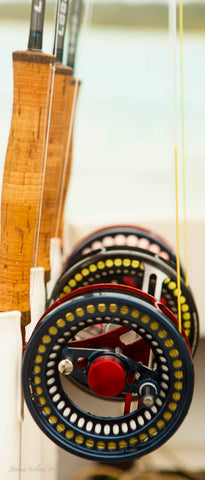
Fly Reel
Ages ago, when the Macedonians began to fool local trout and grayling with artificial flies, there were no fly reels. These anglers would hold gathered silken fly line in a bunched and folded wad in their free hand. It’s easy to see the potential pitfalls in such a system and it was only a matter of time before someone chose to solve the problem and introduce a mechanized way to manage line. Since the introduction of the first modern fly reels in the 1800s, the sport of fly fishing and its techniques have changed dramatically.
The fly fishing reel is a compact and efficient machine designed to store, dispense, and retrieve the fly line and backing. Fly reels also provide an angler with the welcome assistance of a mechanical drag or braking system that helps slow down a running fish. These devices are generally constructed of high-grade aluminum and can be highly engineered with the assistance of computer software commonly found in architecture and design firms, or they can be “funny paper simple” in their functionality.

Today’s Fly Reels
Modern fly reels consist of five major design elements: an external frame for durability, a reel foot for easy attachment to the fly rod, an arbor for line storage, dispensing, and retrieval, an internal drag system that can help an angler maintain optimal fighting pressure against a fiercely running or very large fish, and of course, a handle to make the whole system go round.
Fly fishing reels are single-action, which means one revolution of the handle gives you a single revolution of the spool (multi-action or “multiplier” fly reels have been developed and marketed on and off for decades, but the best fly reel models have been of the single-action style).
Generally, the smallest and lightest fly reels are termed “standard arbor reels.” Mid arbor designs boast a wider-diameter spool, yielding a slightly faster retrieve, and large arbor reels give the fastest line retrieval or pick up speeds available. When fishing for strong-running fish like steelhead, tarpon, bonefish, and other saltwater species, large and mid arbor fly reels are the most useful, as these fish can run toward an angler creating the need to gather line quickly.
Construction and Durability of best fly reels
Machined Aluminum
The most structurally sound reels are constructed of machined aluminum, entirely cut from bar stock in the way the David was carved from a block of marble. Elegant in their simplicity, machined reels are extremely dynamic, yet are comprised of the fewest assembled parts, so there’s fewer things that can go wrong. Sophisticated design standards ensure these reels function as a smoothly spinning whole. Ounce for ounce, these reels are the strongest and most precise on the market. Drag systems can produce lots of friction and lots of heat. Machined reels also allow for ventilation in the system, reducing the possibility that the drag system will freeze or lock up due to overheating.
Anodization and Lubrication
Keeping grit and grime out of your fly reel is important. Low or no-maintenance lubrication and a durable finishing process are critical characteristics that increase the life of your reel and safeguard against mechanical breakdown.
Optimize the fly reel to perform its best
Smooth Rotation Engagement
Start-up inertia is the single biggest obstacle to landing a fish, whether line is coming in or the fish is running out. A reel that requires the smallest amount of energy to start turning, avoiding a “spike” in sudden resistance, is the best choice when seeking to reduce stress on a fish taking line. Such spikes in start-up energy can place stress on terminal tackle, snapping leaders and light tippet in an instant. In this respect, a fly reel is only as good as its drag system, and a drag system is only as good as the materials and design that go into it.
Cork Disc Drag
Drag systems employing cork and synthetic discs (usually Rulon) consistently perform at the top of industry standards. These are the smoothest systems around; they dampen the transition from stillness to rotation resulting in the least-jarring spool engagement and fewer fish lost to start-up jolts and other snags in the energy transfer system. That may sound like a mouthful, but it means fewer broken tippets and more successful landings. The materials that go into a great drag system must be durable enough to withstand high levels of pressure, heat, and friction. Retaining its shape no matter the drag pressure, treated cork has proven to be a superior drag material because of its compressibility.
Arbor
The arbor is the interior cylinder of the fly reel; it’s what your fly line wraps around. Recent design trends have emphasized an arbor with a greater circumference. With large arbor reels, line coiling or “memory” is reduced, and the rate of line retrieval is increased. Most importantly, outgoing drag tension is mitigated as line is depleted, decreasing the chance of losing that once-in-a-lifetime trophy on a long run. Fishing a large arbor maintains a tighter connection with the fish, reducing slack and giving you more control over unpredictable fish-fighting conditions.
